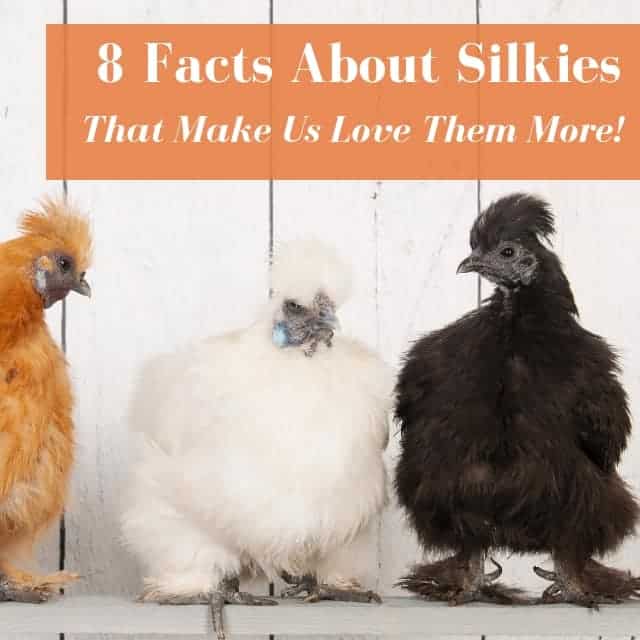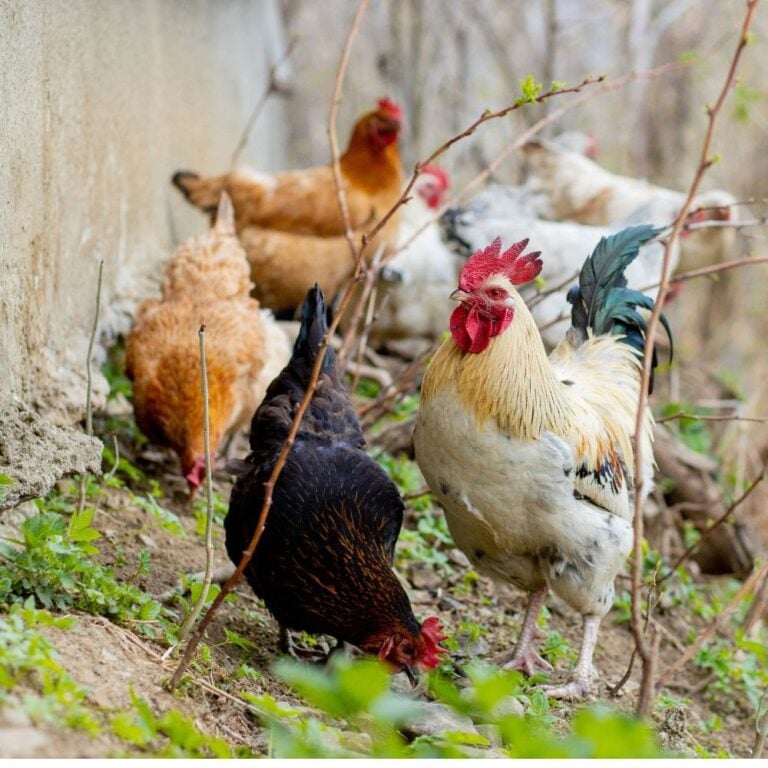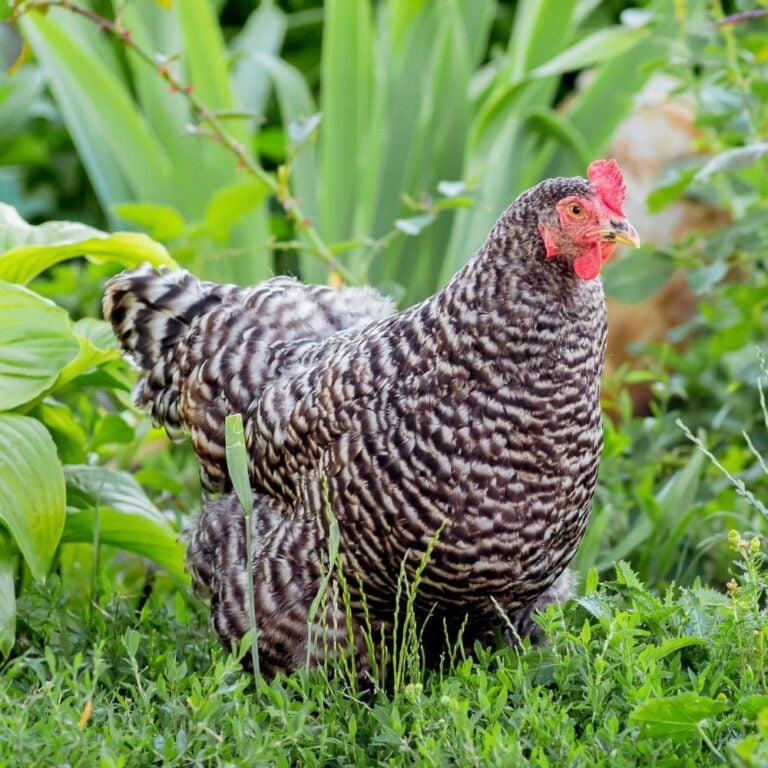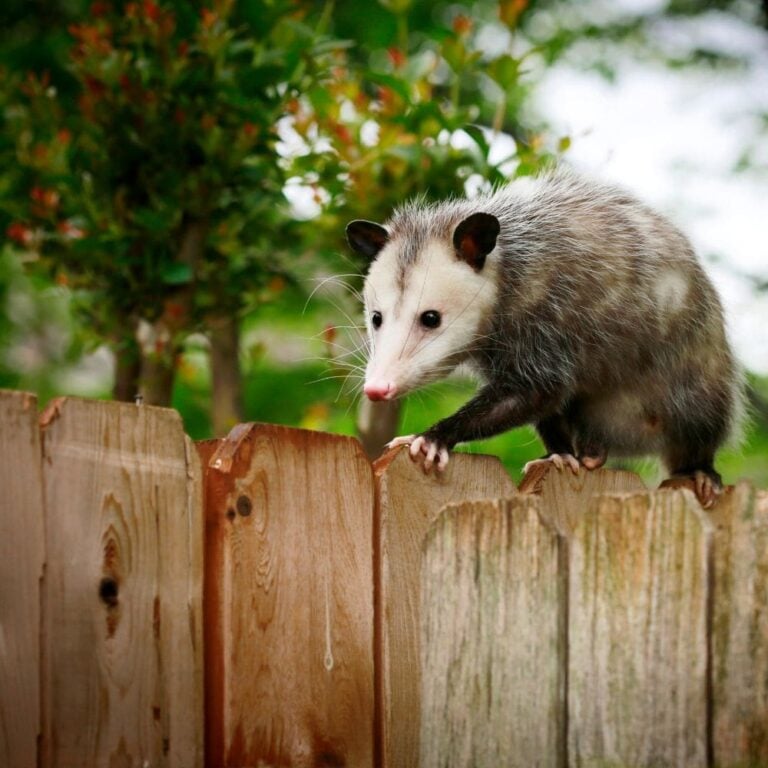Have you heard of a blue chicken? What comes to mind? What comes to my mind is a cobalt-colored chicken which is incredibly appealing to me. There are such things as blue chickens, but it’s not the color we all envision (it’s ok, they are still beautiful).
So then, if blue chickens aren’t cobalt blue (or even sky blue), what shade of blue are they? Follow me to find out!
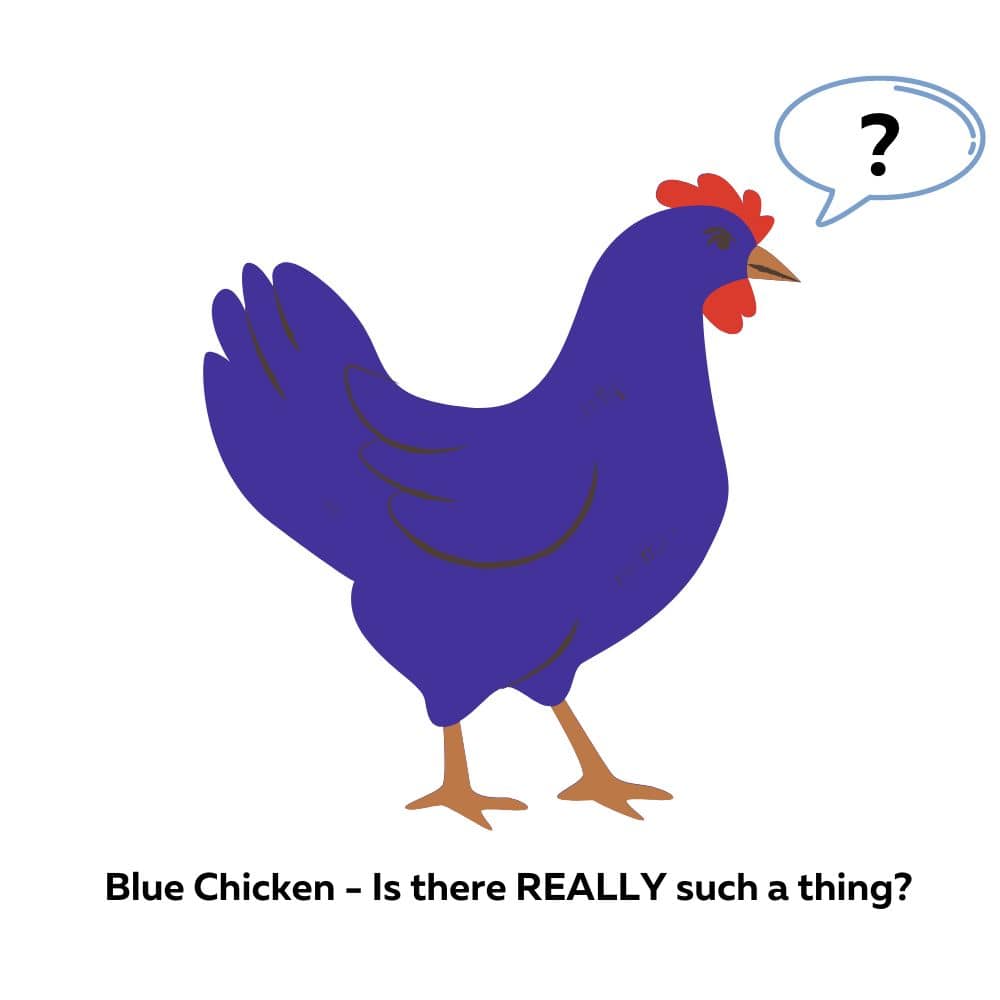
I was teaching a middle school US Geography class when we came across the Delaware Blue Hen as a state bird. The kids were intrigued, so I Googled it so I could show them the true blue color of a blue colored chicken 😁. And to my surprise, the photo that came up was pretty misleading.
I’m here to help you. Chicken facts are important to all of us chicken lovers. 💕
Table of Contents (Quickly Jump To Information)
What Shade of Blue Are Blue Colored Chickens?
There are many breeds that have a blue-colored variety, which may be a surprise in itself. More on that in a bit. Within those breeds, there are, of course, many different shades of “blue” chickens. However, you can safely rely on some shade of slate blue.
Okay, that leads to the next question: What is slate blue? Slate blue is a combination between a muted blue and a light gray…sometimes with a periwinkle undertone. Slate is a natural rock used in building materials such as slate flooring and this is where the color name is derived from.
So…a blue chicken is not the mystical mermaid color one might dream about, rather it’s a lovely slate color. Let’s call it gray with a special twist, shall we?
Blue Chicken Breeds
There are many, many different breeds of chickens that have a gene that codes for blue feathers. Here are some of the most popular breeds of blue chickens:
- Blue Andalusian – The Andalusian chicken is originally from Spain and is known for its blue-tinted feathers.
- Blue Laced Red Wyandotte – One of the most popular blue feathered friends around. They have blue lacing with red feathers, very pretty.
- Blue Copper Marans – These birdies are from France and are known for their chocolate-colored eggs. Blue Copper Marans have a stunning contrast of copper feathers against their blue feathers.
- Blue Araucana – Originally from Chile and lay blue eggs. They are also known for their tufty ear feathers.
- Blue Orpington – Orpingtons are known for their docile nature and egg-laying ability. Top that off with this blue variety and you have a favorite.
- Blue Cochin – This breed is very rare, but also very docile and gentle. They are great for families, especially those that like to show birds.
- Blue Ameraucana – These stunning and elegant birds have irresistible lacing with a deep blue color.
- Blue Sumatra – The Sumatra are lousy egg layers, and are therefore mostly known as ornamental birds, exhibition chickens, and pets. Beautiful but a bit temperamental.
- Blue Silkies – Silkie chickens are super cute and friendly. The blue variety is no different. They can be excellent broody mamas too.
- Blue Australorps – Great egg layers with unique coloring. Their feathers are blue with white wing tips.
As I said, there are many, many varieties of blue chickens. So, if you are interested in becoming a blue chicken collector you aren’t restricted to the list of ten I just gave you.
You can branch out to a Blue Jersey Giant (oh, fun!), a Blue Plymouth Rock chicken, or any number of other blue chicken breeds…like Blue Wyandottes, or maybe a Blue Dutch Bantam or….okay, okay, I’ll stop. But you get the idea!
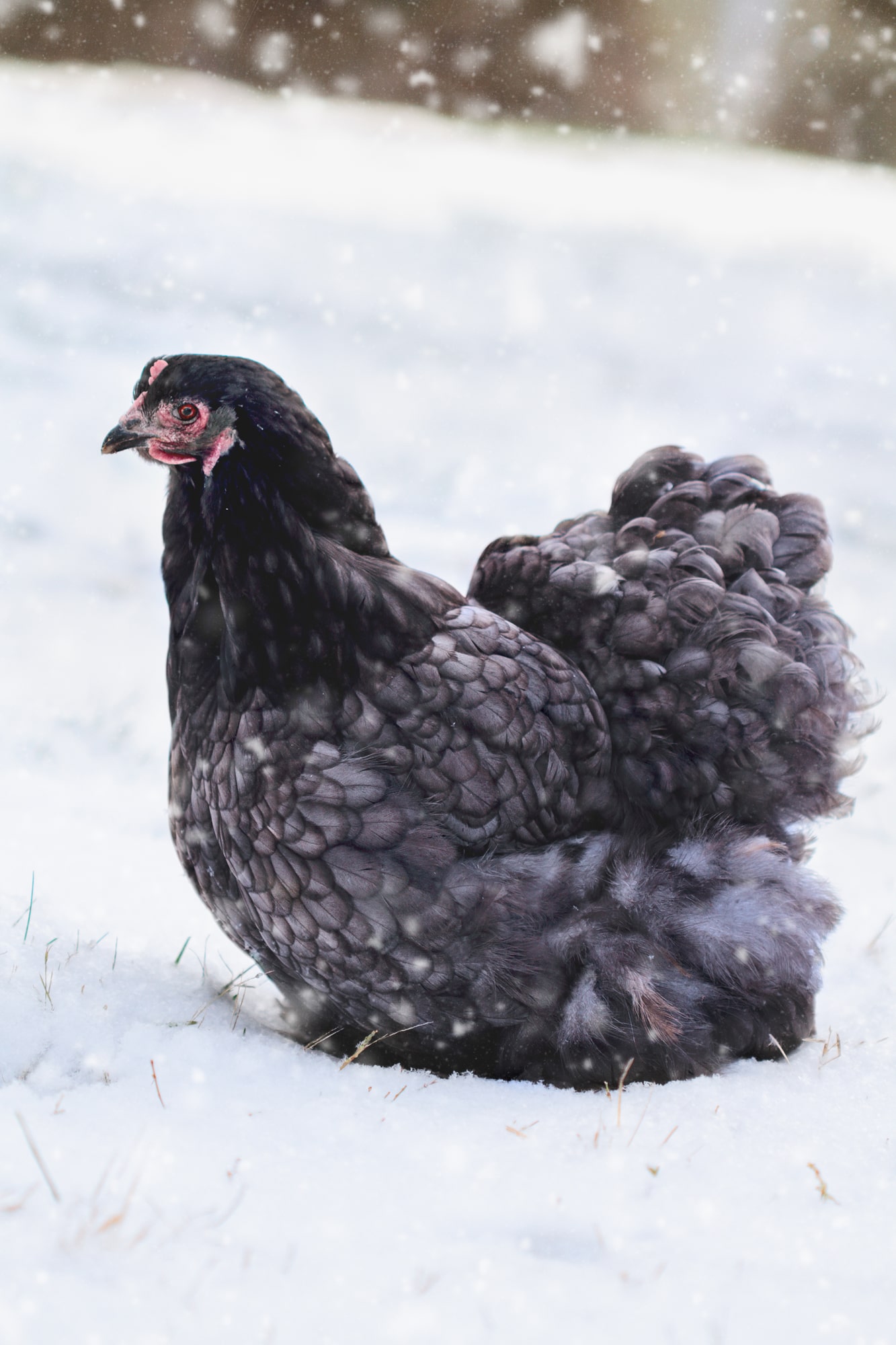
How Do You Breed For a Blue Chicken?
As you might expect, hatcheries know best about this scientific process. Here is what Meyer hatchery has to say:
Genotype
Genotype is the term referring to the genetic makeup of any organism. Mendel’s law of inheritance states that for any genetic trait, a chick receives a gene from each parent. The blue coloring is made from two different genes, black (BB) and splash (bb). By “mixing” these two colors, we are able to achieve blue chicks. If we breed a black (BB) parent to a splash (bb) parent, 100% of the chicks should come out blue (Bb). The chick receives a gene from each parent, a dominant black (B) and a recessive splash (b), which genetically is a blue chick.
When the breeding flock consists of blue birds (Bb), the resulting offspring will contain approximately 25% black (BB) chicks, 50% blue (Bb) chicks and 25% splash (bb) chicks.
Meyer Hatchery
It does sound complicated, and it is if you ask me. Unless you are planning to be a serious breeder, it’s just best to order blue chicks from a hatchery (I’ve linked some of the top hatcheries that carry several varieties of blue chickens below). Are you still longing for more scientific details, you might be interested in knowing what self blue means. So, here you go.
Self Blue
Self Blue is the term used to describe a blue color in poultry that does genetically breed true. Usually, when a breed is genetically self blue, it will be described as a lavender-colored breed. As an example, consider the Lavender Orpington versus the Blue Orpington, similar-looking birds but genetically the former will breed true while the latter will not. Self Blue parents will produce 100% blue (lavender) chicks without the dominant black and recessive splash color variations. You can almost always assume that if any breed is called just “blue” without the “self blue” designation, it may produce the black and splash offspring in addition to the blue.
Meyer Hatchery
Phenotypes
Just when you thought I was done…there is also something called phenotypes. It gets pretty deep into your science book. If you want to read more about genotypes, phenotypes, and other poultry genetics, try this.
Do Blue Chickens Need Special Care?
Even though a blue chicken seems like it may need special care, it’s really just a chicken. The care is the same as any other chicken. Just keep in mind the specific needs of the specific breeds, and you’ll be A-OK. Here are a few general chicken care tips to get you rolling.
- Always provide fresh, clean water. If you give them warm water in cold weather they will appreciate you more and it will encourage continued egg laying.
- Don’t skimp on feed, choose a high-quality feed packed with protein-rich goodies like this one.
- Food is a chicken’s love language, so woo them with treats. But make it count and give them treats that also enrich their diet. Here are my favorites.
- Ensure they have a draft-free, but well-ventilated coop that protects them from the elements and predators.
Bonus: Blue Eggs
Do you know what’s even more fun than blue-colored chickens? Blue egg-laying birds! Learn all about blue egg layers in this article. Keep reading to find out where you can buy blue colored chickens.
Where To Buy Blue Chickens
So, now you want your very own blue chicken…but where do you get one of these beautiful birds? Of course, it depends on what breed you are looking for. Here’s a list to help get you started. Each of these hatcheries has several breeds with a blue variety to choose from.
You can always check local breeders and Facebook groups too.
1. The Chick Hatchery.com
Find more information and prices here: The Chick Hatchery.com
The Chick hatchery is Michigan’s “premier source for superior quality poultry.” With a creed that revolves around the sharing and joy of raising chickens, they operate in no-kill facilities. They raise their chickens humanely, with any unsold chicks going to Amish farms. Much of the experience of raising chickens is the awareness of the individual chicken and the relationship between food and our own health.
Their Lavender Orpington Chickens are available from February through August.
Advantages
- Ships a minimum of 3 of each sex
- All poultry guaranteed live delivery
- Offers discounts on orders of larger quantities of birds
Disadvantages
- Ships a maximum of 15 total chicks (the above discounts do not apply to Lavender Orpingtons, due to their product limitations)
- Does not ship to Hawaii or outside the USA
2. Cackle Hatchery
Find more information and prices here: Cackle Hatchery
Cackle Hatchery proudly boasts that they have been hatching and shipping since 1936. A third-generation hatchery based in Missouri, their mission is to provide customers with quality poultry for showing, meat, enjoyment, and eggs. They ship throughout the USA, including Alaska, Puerto Rico, and Hawaii. They offer nearly 200 different types of chickens at all stages.
Cackle also offers many other kinds of poultry including ducks, waterfowl, game birds, turkeys, and other fowl. They are also a good source of supplies and books. Lavender Orpingtons are available only as baby chicks, and they are a very seasonal bird, available only from early March through July.
Advantages
- Discounts if you buy male chicks
- Vaccinations available
- Only need 3 birds to ship (or just one for male birds)
Disadvantages
- Limited availability (February through September)
- Sold as baby chicks only
3. Murray McMurray Hatchery
Find more information and prices here: Murray McMurray Hatchery
Murray McMurray started his chicken business in 1917. As a banker, he sold his chicks to locals through the bank, and by 1919, he had developed his own stock of chickens. During the Great Depression, he devoted himself to chickens full-time. Since then, Murray McMurray Hatchery has developed into one of the largest chick hatcheries in the country. They sell more than just chickens, with ducks, geese, guineas, turkeys, other fowl, and game birds all in the catalog.
They take great pride in the Lavender Orpingtons that they produce, and are big fans of them.
Advantages
- Very affordable
- Bulk discounts available
- Excellent breed availability with clear Availability chart
- Mixing and matching chick breeds is possible
Disadvantages
- Minimum order of six birds at a time
4. Purely Poultry
Find more information and prices here: Purely Poultry
As a family-owned business, Purely Poultry has some of the best customer service around. They pride themselves on their knowledge of their products, selection, and how-to details related to everything they offer, including ducks, chickens, geese, and lots of other birds!
Located in Durand, WI, they guarantee live birds with every order, which is a good promise, indeed! Lavender Orpingtons are in high demand, thanks in part to their fluffiness.hat
Advantages
- Each order backed by live arrival guarantee
- Small order minimum on chicks
- Other kinds of poultry offered, too
Disadvantages
- Not a huge advantage to buying multiple chicks – discounts are minimal
- Expensive, especially for females. They charge extra on top of the Not Sexed rate.
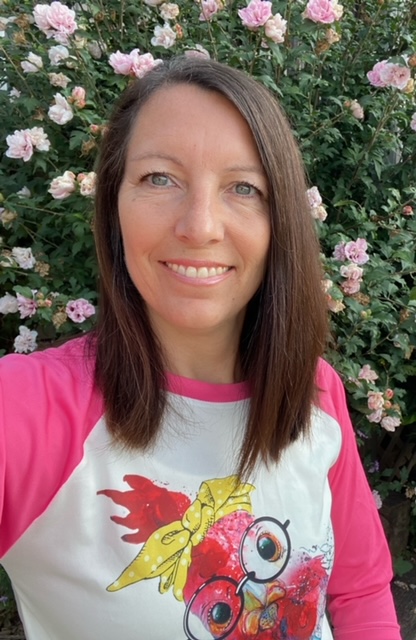
A happy wife, mother, teacher, writer, hobby farmer, lover of chickens, and contributor to Pampered Chicken Mama!

